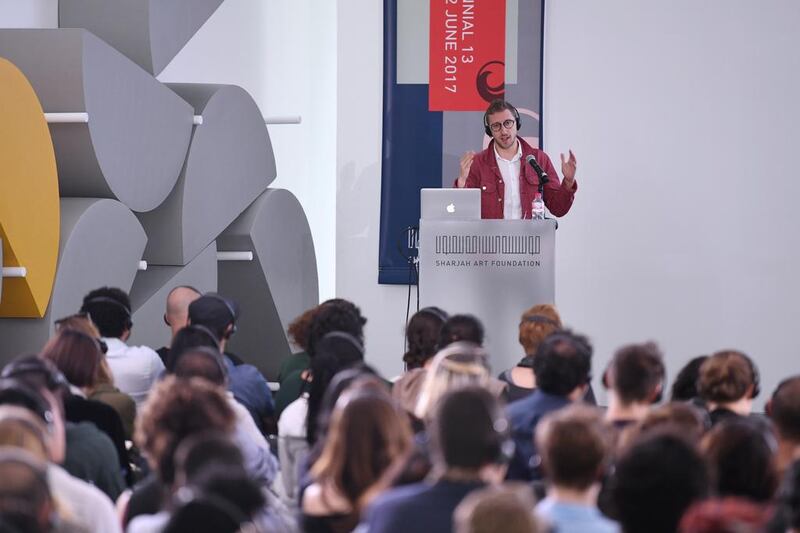Saydnaya Prison is the subject of artist Lawrence Abu Hamdan's work at the Sharjah Biennial. Saydnaya (the missing 19db) (2017) tells the story of a Syrian prison in which "silence became a torture in itself".
Saydnaya, 25 kilometres north of Damascus, was cleared in 2011 in order to incarcerate political prisoners. It has become infamous because of its strict prohibition on sound: speaking aloud is punishable by death.
“People are not allowed to speak even while being beaten,” says Abu Hamdan.
There is almost total sensory deprivation. According to testimonies Abu Hamdan helped to bring to light, prisoners are isolated from each other and are blindfolded when walked through corridors.
“They had to turn to the face the wall even when a guard came into their room,” says the artist.
Prisoners become attuned to any vicissitudes in sound: a guard walking; a door scraping; water dripping; the way other prisoners cough. Those who survived have told of no longer being able to speak at a normal level; their tongues twisted by years of whispering.
Because of the conditions inside, it is difficult for human rights organisations to determine what is happening at Saydnaya. Amnesty International has enlisted the help of research agency Forensic Architecture at Goldsmiths College, London, which develops new means of evidence-gathering for international prosecutors and human rights organisations.
Abu Hamdan works with the team on what he calls “earwitness” testimonies, which rely on sound as much as sight. He and an architecture fellow set up interviews with ex-Saydnaya detainees to reconstruct what was happening at the prison.
“Some of them could tell us how many cells there were in a corridor by remembering how many locks they heard closing at night,” says Abu Hamdan.
He used an echo profiling technique to gauge the size of cells and corridors, playing sounds at different decibels to ex-detainees to determine the level that corresponded to their memories of echoes bouncing off the walls.
Abu Hamdan and the architecture fellow were the first to uncover evidence of executions, from the prisoners’ testimonies of hearing “sounds every week that meant that people were being extracted from their cells, gathered in one cell, and then taken out into a truck”. Fifteen minutes later they would hear the lorries returning, empty. “Later Amnesty spoke to defectors who confirmed what was happening,” he says.
The artist, who was born in Jordan, grew up in Yorkshire, England, and now lives in Beirut. He is unusual in that he makes artwork but also helps to create testimonies for legal and historical investigations.
Abu Hamdan is now using material from the Saydnaya witnesses to develop a series of artworks, of which the Sharjah Biennial commission is the first. The installation plays with the way sound can be so present that it becomes material.
Two voices in a darkened room recall the conditions in the prison, while on the floor, the levers of a sound mixer move up and down: to provide a visual representation of the subject.
Together with Nesrine Khodr, who plays the role of translator (the installation is in Arabic and English), Abu Hamdan recorded the witness testimonies with their mouths close to the microphone, to make the sounds feel almost physical in the room.
The artist also explored other applications for sound through a performance at the biennial's opening, Bird Watching (2017), in which he addressed recent human rights cases such as that of Michael Brown, the unarmed black teenager shot in Ferguson, Missouri, in 2014, and the potential for the gunshot sounds to be used in reconstructing the truth of what happened. He hones in on the malleability of "truth" in the witness testimonies, and even in personal memories.
Because of long stints in Saydnaya Prison, Abu Hamdan says “for the prisoners, memories themselves are under attack”.
“There are often images that are recollected as if they were seen – but they were only heard. I look at places where the truth becomes fragile.”
After working with sound and music, Abu Hamdan credits an encounter with University of York linguistics professor Peter French in 2010 for helping him to understand the potential for his work beyond the art landscape. How French considered sound “was markedly different from how it was being considered artistically or academically, where there was a kind of exceptionability around sound, focusing on its ephemerality and intangibility,” he explains.
“French treated it like a material, something you could cut open and dissect and learn from – and with this materiality you have a politics.”
Abu Hamdan says his art training provided him with a different perspective on how testimonies can be constructed, both in an arts context and in the human rights arena. “Every kind of presentation of evidence is a kind of aesthetic act,” he says.
He notes that artists are tasked to understand the structures around their work as part of their work itself, “like how the light on a painting becomes part of the painting”. “That kind of attention when looking at the world inspires me to undertake these investigations.”
artslife@thenational.ae











